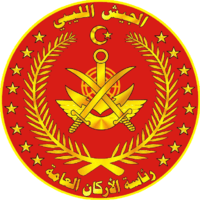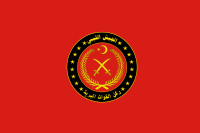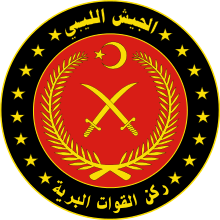Libyan National Army
| Military of Libya | |
|---|---|
| القوات المسلحة الليبية | |
  Libyan National Army logo and flag | |
| Founded | 1951–1969 |
| Current form | 2011 |
| Service branches |
|
| Leadership | |
| Commander-in-Chief | Aguila Saleh Issa |
| Chief of Staff | Major General Abdulrazek Al Nadoori (Tobruk-based government) |
| Manpower | |
| Military age | 18 |
| Available for military service |
1,775,078[1] males, age 15–49, 1,714,194 females, age 15–49 |
| Fit for military service |
1,511,144 males, age 15–49, 1,458,934 females, age 15–49 |
| Reaching military age annually |
59,547 males, 57,070 females |
| Active personnel | 35,000[2] (ranked 74th) |
| Industry | |
| Foreign suppliers |
|
The Libyan National Army is the national armed force of Libya, comprising the ground forces, the air force and the navy. It was established by the Libyan government after the first Libyan civil war (2011), as Libya's previous national army was defeated by the uprising and NATO and was disbanded.
In the ongoing Second Libyan Civil War (2014–present), the Libyan National Army is loyal to the legislative body in Tobruk, the Libyan House of Representatives, internationally recognised until October 2015. It therefore fights against the Islamist Libya Dawn, the Shura Council of Benghazi Revolutionaries and the Islamic State in Libya.
At the beginning of the Second Libyan Civil War, the army was split between Khalifa Haftar's "anti-terrorist" faction, which acted largely independently, and Abdulsalam al-Obaidi's "legalist" faction which relied on orders from political authorities. In 2014, the Council of Deputies appointed Haftar commander of the whole army, re-uniting the two factions. Abdulrazek Al Nadoori is chief of staff.
In the case of the many armed groups in Libya, they do not belong to the Libyan National Army unless they pledge allegiance to it. Many armed groups that exist in areas outside the control of the Council of Deputies and the Libyan National Army accept government funding and openly exert authority associated with official forces, while not have a commitment to obey the Libyan National Army hierarchy or the government. As the Second Libyan Civil War progresses, armed groups are increasingly condemned by the Council of Deputies and have been branded illegal.
Structure of the National Army
Ground Forces

Formations include:
- 17th Thunderbolt Special Forces Brigade - Tripoli
- 27th Brigade - Tripoli.[3]
History
The Libyan National Army was founded in 2011 by the National Transitional Council, after forces aligned to it defeated the previous Libyan Army and overthrew Muammar Gaddafi's regime. Supply depots and bases having been damaged during the civil war, the new army is faced with the challenge of having to rebuild much of the country's military infrastructure.[4] Yousef Mangoush was named as its first Chief of Staff on 2 January 2012 and the force saw its first major deployment on 23 February, when it was deployed to Kufra to intervene in a tribal conflict.[5]
In November 2011, the National Transitional Council begun the difficult process of restructuring the army, with military personnel who defected from the Gaddafi government and former rebel fighters of the National Liberation Army forming the basis of the new Libyan Army. Major General Khalifa Belgacem Haftar was chosen as the overall commander of the new Libyan Army due to his military experience and loyalty to the revolution that overthrew Gaddafi.[6]
The Libyan Army only numbered "a few thousand" trained soldiers in November 2011, and was rapidly trying to train up new fighters who could keep the peace nationwide and deter rogue militias from acting without NTC orders, and was responsible for brokering a ceasefire on at least one occasion in November between warring militas from Zawiya and Al Maya.[7]
On 1 December 2011, it was reported that the National Liberation Army was to integrate up to 50,000 former rebel fighters into the new Libyan national army and police forces, with the aid of French training, with long term aims to integrate as many as 200,000 fighters from the brigades that had fought against Gaddafi during the civil war.[8]
In December 2011, Italy agreed to provide training the Libyan Army as it attempted to reorganize in the aftermath of the civil war.[9][10]
Also in December, large numbers of former rebels were being given jobs in the new army, whilst the government also announced that they would be free to join the special forces and the navy too. According to Osama al-Juwaili, the defence minister: "The idea is to inject new blood in the army which was marginalised by the tyrant (Gaddafi)"[11]
General Yousef Mangoush said on 5 January 2012 that Libya's new army faces major obstacles such as rebuilding bases destroyed during the conflict, as well as disarming militias that were not part of the new army. National Army commander General Khalifa Haftar said later that it could take between three and five years for Libya to field a capable enough army to protect its borders.[12]
On 7 May 2013, Libya’s Defense Minister Mohammed al-Barghathi resigned on Tuesday due to a crisis caused by gunmen who have besieged two ministries for more than a week, a ministry official said. He later withdrew his resignation after Prime Minister Zeidan convinced him to stay.[13]
Under an agreement reached at the Lough Erne G8 summit in June 2013, NATO countries the United Kingdom, Italy, Turkey, and the United States undertook to help train up to 15,000 personnel from Libyan National Army units over a two-year period. They were to take units from newly formed brigades for 10-week stints of intensive infantry training. The 27th Brigade was due to start at Bassingbourn in eastern England in January 2014.[3] As a result of disorder and sexual assaults by some Libyan army cadets, the UK cancelled the programme in November 2014. The Libyan trainees were sent back to Libya, with the exception of five who were tried for sexual offenses.[14]
Al-Saiqa is an elite army unit, formed from a mixture of paratroopers and commandos. It numbers a few thousand and reports to the Ministry of Defence. It is popular in Benghazi, particularly in light of its opposition to Islamist Ansar al-Sharia group and because it is seen as a symbol of the reborn Libyan armed forces.[15]
Equipment
Whilst it is known to a degree what equipment the Libyan National Army uses, the exact numbers of the below equipment currently in use is not known. What is certain is that a reasonable quantity of their equipment probably came from ransacked stocks of the original Libyan Army and from defectors as well.
Small arms
| Name | Country of origin | Type | Caliber | Notes |
|---|---|---|---|---|
| NATO Standard | ||||
| FN P90[16][17] | Personal defence weapon | FN 5.7×28mm | ||
| Beretta 92FS[18] | Pistol | 9×19mm | ||
| CZ99 | ||||
| Beretta M12[19] | Submachine gun | |||
| Zastava M21[20] | Assault rifle | 5.56×45mm | Most likely used by special forces. | |
| FN F2000[21] | Most likely used by special forces. | |||
| FN FAL | Battle rifle | 7.62×51mm NATO | ||
| Heckler & Koch G3[22] | ||||
| Zastava M07 | Most likely used by special forces. | |||
| Zastava M93 Black Arrow[23] | Sniper rifle | 12.7×99mm | Most likely used by special forces. | |
| Benelli M4[24][25] | Shotgun | 12 gauge | Used by special forces | |
| Soviet Standard | ||||
| TT-33 | Pistol | 7.62×25mm | ||
| AK-47[26][27] | Assault rifle | 7.62×39mm | ||
| AKM | ||||
| Dragunov sniper rifle | Sniper rifle | 7.62×54mmR | ||
| Zastava M91[23] | ||||
| RPK | General-purpose machine gun | 7.62×39mm | ||
| PK machine gun[28] | 7.62×54mmR | |||
| Degtyaryov machine gun | ||||
| Zastava M84 | ||||
| DShK | Heavy machine gun | 12.7×108mm | ||
| Zastava M02 Coyote[20] | ||||
Technicals
A variety of pickup/utility vehicles, called technicals and gun trucks, often Toyota and other makes, armed with a variety of different weapons, including heavy machineguns, light MLRS' and anti-aircraft guns, most commonly used is the ZU-23-2 and the ZPU.[29][30]
Tanks
Armoured personnel carriers







Artillery



Portable Anti-Tank Weapons


.svg.png)

Anti-Tank Guided Missiles




Self-Propelled Anti-Air Gun
Helicopters



See also
| Wikimedia Commons has media related to Military of Libya. |
References
![]()
- ↑ "The World Factbook". CIA. Retrieved 2013-02-05.
- ↑ Worth, Robert F. (13 May 2012). "In Libya, the Captors Have Become the Captive". The New York Times. Retrieved 24 May 2012.
- 1 2 "UK trains Libyan army in fight against al-Qaida and warlords". The Observer. Retrieved 29 Dec 2013.
- ↑ "Libya's new military chief to disarm former rebels". USA Today. 2012-01-04. Retrieved 24 May 2012.
- ↑ "New Libya army flexes muscles to halt tribal fight". Reuters. 23 February 2012. Retrieved 24 May 2012.
- ↑ "Libya: New Chief for Revamped National Army". AllAfrica.com. 2011-11-17. Retrieved 2013-02-05.
- ↑ Krauss, Clifford (2011-11-21). "Libyas toughest test may be building an army". The New York Times. Retrieved 2013-12-07.
- ↑ "Libya to integrate 50,000 anti kadhafi fighters". France24.com. 2011-12-01. Retrieved 2013-12-07.
- ↑ "Turkey to Train Libya's Army". Turkishweekly.net. Archived from the original on 2013-12-12. Retrieved 2013-12-07.
- ↑ "Turkey to Train Libya's Army « Shabab Libya". Shabablibya.org. Retrieved 2013-02-05.
- ↑ "Former Libyan rebels offered military jobs". The Daily Telegraph. London. 26 December 2011.
- ↑ "Libya army chief of staff wants to disarm fighters". Zeenews.india.com. 2012-01-05. Retrieved 2012-01-05.
- ↑ "Libyan defence chief reverses move to quit, gunmen press siege". English.alarabiya.net. Retrieved 2013-12-07.
- ↑ "Libyan troops sent home after sexual assault allegations". The Guardian. 5 November 2014.
- ↑ "Guide to key Libyan militias and other armed groups". BBC. 28 November 2013.
- ↑ Fux, Eric (April 21, 2011). "Bericht van het front in Libië" (in Dutch). De Redactie. Archived from the original on May 1, 2011. Retrieved May 2, 2011.
- ↑ "FN-Libye: Demotte Justifie l'Autorisation Wallonne" (in French). La Libre Belgique. 2009-10-05. Retrieved 2010-01-05.
- ↑ Diez, Octavio (2000). Armament and Technology. Lema Publications, S.L. ISBN 84-8463-013-7.
- ↑ Gander, Jerry (2002). Jane's Infantry Weapons 2002–2003. Jane's Information Group. pp. 214, 899–906. ISBN 0-7106-2434-4.
- 1 2 http://www.zastava-arms.rs/
- ↑ "Libyan rebels show a FN F2000 assault rifle with grenade launcher they found…". Uk.news.yahoo.com. 2011-09-05. Archived from the original on 2014-09-08. Retrieved 2013-02-05.
- ↑ Jones, Richard D.; Ness, Leland S., eds. (2009-01-27). Jane's Infantry Weapons 2009/2010 (35th ed.). Coulsdon: Jane's Information Group. ISBN 978-0-7106-2869-5.
- 1 2 3 http://www.danas.rs/danasrs/ekonomija/krenuo_izvoz_pesadijskog_naoruzanja_za_libiju.4.html?news_id=279435
- ↑ "Benelli M4 Super 90 / M1014 JSCS Semi-Automatic Combat Shotgun (1999)". Military Factory. February 5, 2014. Retrieved 2014-12-23.
- ↑ Giorgio Beretta Mercoledì, 09 Marzo 2011 (2011-02-27). "L'Italia ha inviato 11mila Beretta semiautomatici al regime di Gheddafi / Notizie / Home" (in Italian). Unimondo. Retrieved 2013-10-09.
- ↑ "Brit held with SAS in Libya was spy". London: The Sun. 2011-05-17. Retrieved 2013-02-05.
- ↑ "The Libyan Revolution One Year On: Carla's Story". Shabab Libya. Retrieved 2013-02-05.
- ↑ http://operatorchan.org/v/res/1343+50.html. Retrieved 2012-06-19. Missing or empty
|title=(help) - ↑ "A rebel fighter celebrates as his comrades fire a rocket barrage toward Gaddafi forces west of Ajdabiyah, Libya, April 14, 2011". Atlantic Council. 2011-04-14. Archived from the original on May 27, 2013. Retrieved 2013-02-05.
- 1 2 3 4 "Libya: How the opposing sides are armed". BBC News. 2011-08-23. Retrieved 2013-02-05.
- ↑ "Libya rebels make gains towards Tripoli". Channel 4 News. 2011-08-18. Retrieved 2013-02-05.
- ↑ Jonathan Marcus (10 March 2011). "Gaddafi loyalists mount onslaught". BBC. Retrieved 11 March 2011.
- ↑ "Libya: Rebels fight street battles in Zawiya". BBC News. 19 August 2011. Retrieved 20 August 2011.
- ↑ "Libyan Interim Forces Await Decision to Attack". English.alarabiya.net. 5 September 2011. Retrieved 11 November 2011.
- ↑ David Zucchino (2011-03-31). "Libya fighting: Libya rebels flee eastward by the hundreds". Los Angeles Times. Retrieved 2013-02-05.
- ↑ "Citizens of Benghazi Parade On A Captured Btr Apc". Wn.com. Retrieved 2013-02-05.
- ↑ "Who Are the Rebels Fighting Libyan Government Forces?". Voanews.com. 2011-03-29. Retrieved 2013-02-05.
- 1 2 "Libyan Conflict - Photos and Videos - Page 264". Militaryphotos.net. Retrieved 2013-02-05.
- ↑ "Russians deliver armoured fighting vehicles". Libya Herald. Retrieved 2013-12-07.
- ↑ "Libya has taken delivery of 49 NIMR 4x4 light tactical armoured vehicles from Jordan 2502133 - Army Recognition". Armyrecognition.com. Retrieved 2013-12-07.
- ↑ "Libya has received 20 Italian-made Puma wheeled armoured vehicles personnel carrier Italy 0303131 - Army Recognition". Armyrecognition.com. Retrieved 2013-12-07.
- ↑ "Libyan army has taken delivery of 200 HMMWV Humvees from United States 3007131 - Army Recognition". Armyrecognition.com. Retrieved 2013-12-07.
- ↑ "Libya uprising: The battle on the road to Sirte". BBC News. 25 August 2011. Retrieved 26 August 2011.
- ↑
- ↑
- ↑ "قائد الطائره الذي رفض قصف بنغازي". YouTube. 2011-06-29. Retrieved 2013-02-05.
- ↑ "US mission in Libya's Benghazi attacked: embassy". Archived from the original on June 9, 2012. Retrieved June 19, 2012.
- ↑ "Libya unrest: Benghazi revels in freedom from Gaddafi". BBC News. 2011-02-26. Retrieved 2013-02-05.